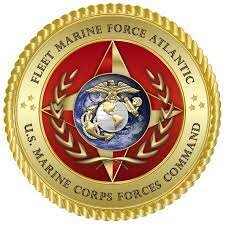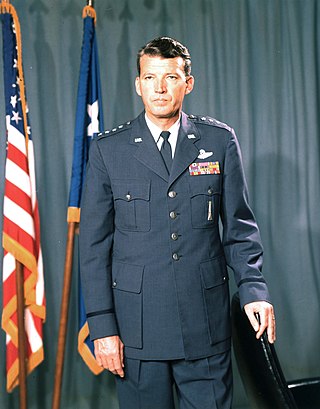The United States Armed Forces are the military forces of the United States. The armed forces consist of six service branches: the Army, Marine Corps, Navy, Air Force, Space Force, and Coast Guard. All six armed services are among the eight uniformed services of the United States, along with the U.S. Public Health Service Commissioned Corps and the NOAA Commissioned Officer Corps.
In military aviation, a wing is a unit of command. In most military aviation services, a wing is a relatively large formation of planes. In Commonwealth countries a wing usually comprises three squadrons, with several wings forming a group. Each squadron will contain around 20 planes.

Force Reconnaissance (FORECON) are United States Marine Corps deep reconnaissance companies that provide military intelligence to the command element of the Marine Air-Ground Task Force (MAGTF). Force Reconnaissance companies report to the Marine expeditionary force (MEF) and provide direct action and deep reconnaissance during large-scale operations.
A group is a military unit or a military formation that is most often associated with military aviation.

The Headquarters Marine Corps (HQMC) is a headquarters staff within the Department of the Navy which includes the offices of the Commandant of the Marine Corps, the Assistant Commandant of the Marine Corps and various staff functions. The function, composition, and general duties of HQMC are defined in Title 10 of the United States Code, Subtitle C, Part I, Chapter 506.

The U.S. Army Test and Evaluation Command, or ATEC, is a direct reporting unit of the United States Army responsible for developmental testing, independent operational testing, independent evaluations, assessments, and experiments of Army equipment.

The United StatesFleet Marine Forces (FMF) are combined general and special forces within the United States Department of the Navy that perform offensive amphibious or expeditionary warfare and defensive maritime employment. The Fleet Marine Forces provide the National Command Authority (NCA) with a responsive force that can conduct operations in any spectrum of conflict around the globe.

The United States Marine Corps is organized within the Department of the Navy, which is led by the Secretary of the Navy (SECNAV). The most senior Marine commissioned officer is the Commandant of the Marine Corps, responsible for organizing, recruiting, training, and equipping the Marine Corps so that it is ready for operation under the command of the unified combatant commanders. The Marine Corps is organized into four principal subdivisions: Headquarters Marine Corps, the Operating Forces, the Supporting Establishment, and the Marine Forces Reserve.

The Marine Corps Systems Command (MCSC) is the acquisition command of the United States Marine Corps, made up of Marines, sailors, civilians and contractors. As the only systems command in the Marine Corps, MCSC serves as Head of Contracting Authority and exercises technical authority for all Marine Corps ground weapon and information technology programs. MCSC is headquartered at Marine Corps Base Quantico.
The structure of the United States Navy consists of four main bodies: the Office of the Secretary of the Navy, the Office of the Chief of Naval Operations, the operating forces, and the Shore Establishment.

Marine Operational Test and Evaluation Squadron One (VMX-1) is a United States Marine Corps operational test squadron consisting of multiple aircraft types. The squadron is based at Marine Corps Air Station Yuma, Arizona. VMX-22 stood up in August 2003 and was redesignated VMX-1 in May 2016. VMX-1 conducts operational test under the authority of the Commander, Operational Test and Evaluation Force (COMOPTEVFOR) and the Director, Marine Corps Operational Test and Evaluation Activity (MCOTEA) depending on the program under test.

The United States Marine Corps Aviation (USMCA) is the aircraft arm of the United States Marine Corps. Aviation units within the Marine Corps are assigned to support the Marine Air-Ground Task Force, as the aviation combat element, by providing six functions: assault support, antiair warfare, close air support, electronic warfare, control of aircraft and missiles, and aerial reconnaissance. The Corps operates rotary-wing, tiltrotor, and fixed-wing aircraft mainly to provide transport and close air support to its ground forces. Other aircraft types are also used in a variety of support and special-purpose roles. All Marine Corps aviation falls under the influence of the Deputy Commandant for Aviation, whose job is to advise the Commandant of the Marine Corps in all matters relating to aviation, especially acquisition of new assets, conversions of current aircraft, maintenance, operation, and command.

The Fleet Marine Force, Atlantic (FMFLANT) is an American maritime landing force that is spread across the Atlantic Ocean. It is headquartered at Naval Station Norfolk and directs and commands all the subordinate elements of the Navy Expeditionary Strike Force and Marine Air-Ground Task Force components that follow under the 2nd, 4th, and 6th Fleet and the Marine Forces Command (MarForCom). The Commanding General of Marine Forces Command is dual-posted as the Commanding General of the Fleet Marine Force, Atlantic. FMFLANT is under operational control of the Commander-in-Chief, United States Fleet Forces Command, when deployed.

The Operational Test and Evaluation Force (OPTEVFOR) is an independent and objective agency within the United States Navy for the operational testing and evaluation (OT&E) of naval aviation, surface warfare, submarine warfare, C4I, cryptologic, and space systems in support Navy and Department of Defense acquisition programs.
Marine Tactical Data System, commonly known as MTDS, was a mobile, ground based, aviation command and control system developed by the United States Marine Corps for the execution of anti-air warfare in support of the Fleet Marine Force (FMF). It was the Marine Corps' first semi-automated system capable of collecting, processing, computing and displaying aircraft surveillance data while also sharing that information with other participating units via tactical data link. The system was developed in the late 1950s/early 1960s when it was recognized that due to the speed, range and complexity of fighter aircraft operations effective air control and air defense demanded enhanced situational awareness.

Marine Air Control Squadron 3 (MACS-3) was a former United States Marine Corps aviation command and control squadron. During its later years it also served as an operational test and evaluation squadron. Originally formed in World War II as Air Warning Squadron 12 (AWS-12), its original mission was to provide aerial surveillance and ground-controlled interception (GCI) for Marine Corps forces during amphibious operations. The squadron did not participate in combat operations during WWII however it did deploy and operate during the Korean War. In 1961, MACS-3 was transferred from the Fleet Marine Force to the administrative control of Air, Fleet Marine Forces Pacific in order to serve as the operational test and evaluation squadron for what was at the time, the largest research and development project in the Marine Corps - Marine Tactical Data System (MTDS). After MTDS testing was complete the Marine Corps recognized that it was not properly staffed to develop, test, and acquire new digital equipment. On 1 July 1970, MACS-3 was decommissioned and its structure and equipment were utilized to form Marine Corps Tactical Systems Support Activity (MCTSSA) at Marine Corps Base Camp Pendleton, California. Of note, MCTSSA does not carry MACS-3's lineage and honors.

While the United States Space Force gained its independence on 20 December 2019, the history of the United States Space Force can be traced back to the beginnings of the military space program following the conclusion of the Second World War in 1945. Early military space development was begun within the United States Army Air Forces by General Henry H. Arnold, who identified space as a crucial military arena decades before the first spaceflight. Gaining its independence from the Army on 18 September 1947, the United States Air Force began development of military space and ballistic missile programs, while also competing with the United States Army and United States Navy for the space mission.










